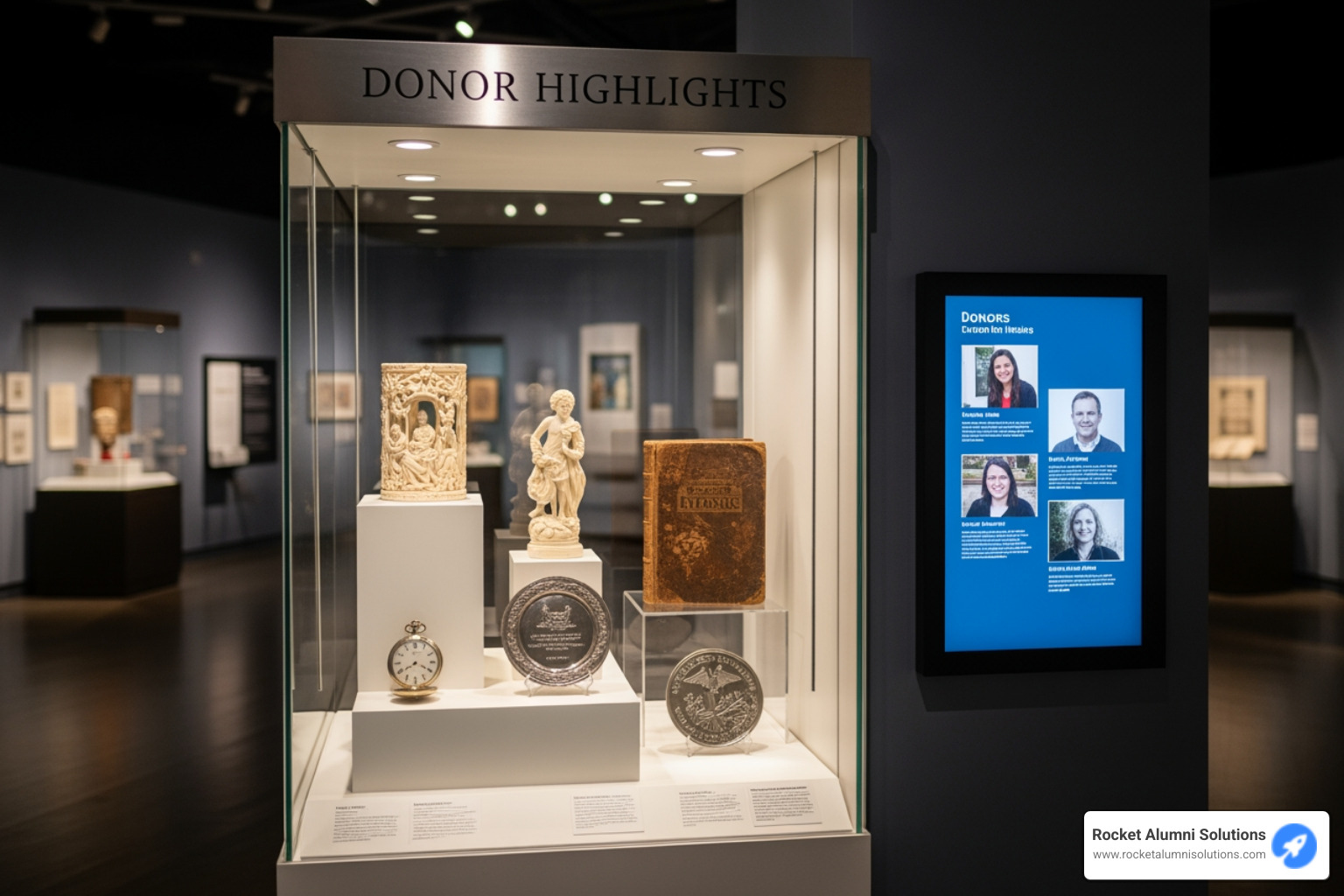Why Digital Donor Recognition is Changing University Philanthropy
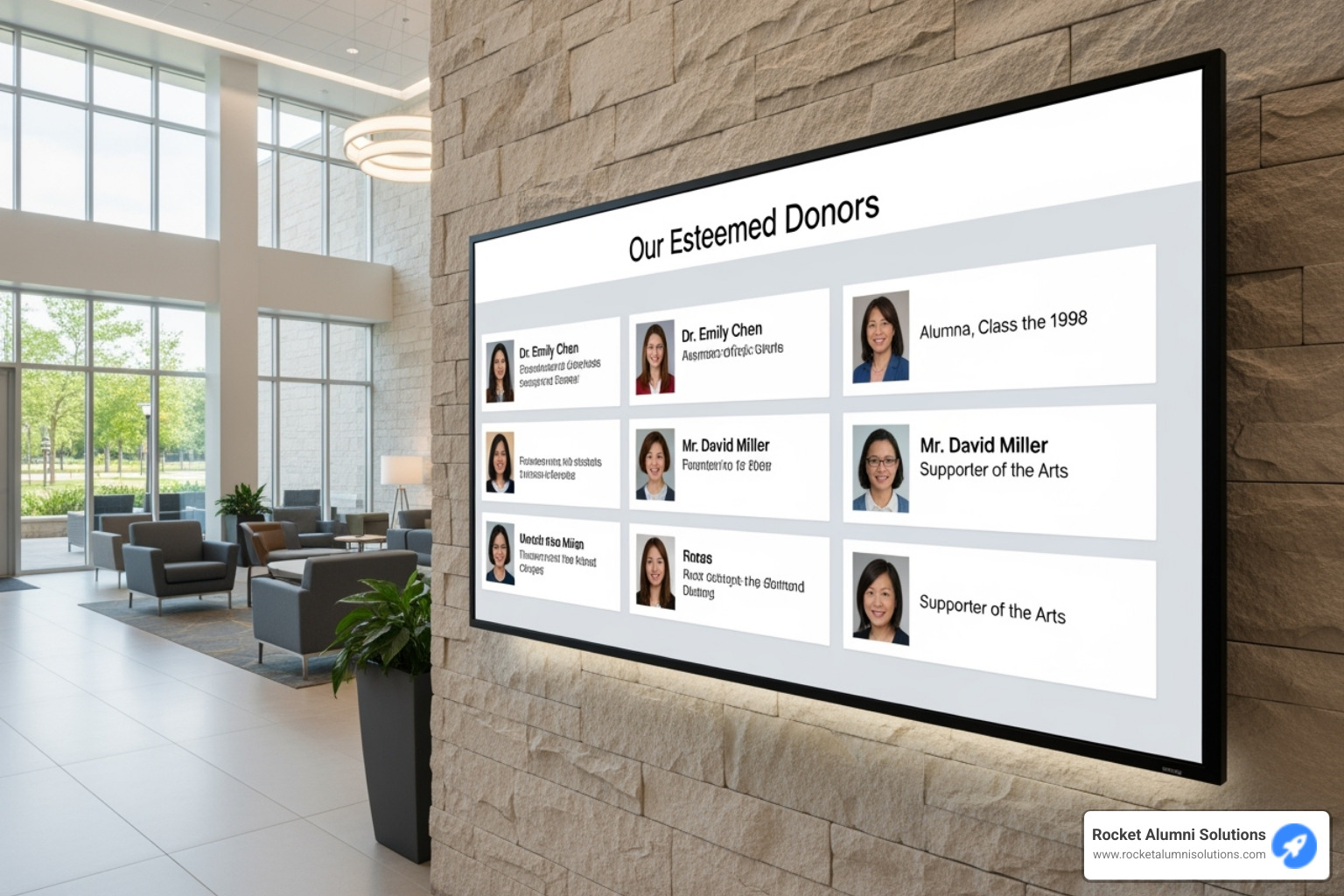
Digital donor recognition is replacing static plaques with interactive, multimedia experiences. Unlike fixed walls that are costly to update and quickly become outdated, digital systems allow for instant changes, virtually unlimited capacity, and rich storytelling through video, photos, and impact data. The result is lower long-term costs, stronger engagement, and higher donor retention.
Traditional donor walls face significant limitations. Space constraints force difficult decisions, while update costs for new plaques divert resources from your mission. Most importantly, static walls cannot demonstrate impact, limiting the emotional connection that drives continued giving.
Digital displays solve these challenges by creating dynamic experiences. A development officer can walk a prospect through an interactive display, showing compelling stories of student impact. A donor can share their recognition on social media with a single tap, expanding your institution's reach. This represents a fundamental shift in how institutions build lasting relationships with supporters.
I'm Chase McKee, Founder and CEO of Rocket Alumni Solutions. We've helped hundreds of schools and nonprofits use digital donor recognition to increase repeat donations by over 25%. Effective programs create personalized experiences that help every contributor see their impact and feel a genuine connection to your mission.
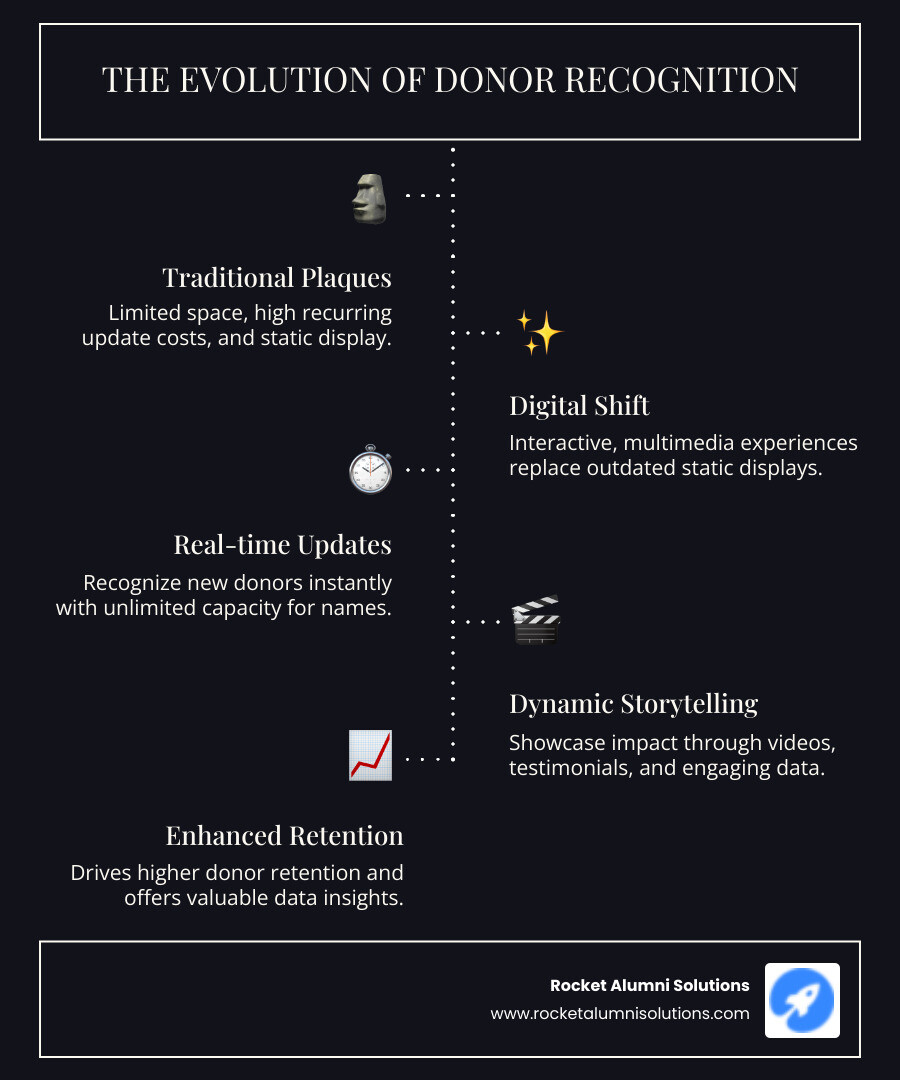
The Shift from Static to Dynamic: Why Digital Recognition is a Game-Changer
For generations, universities honored supporters with engraved plaques and commemorative bricks. These traditional methods carried a certain gravitas but came with serious limitations, such as being expensive to update, having limited space, and being unable to tell a compelling story of impact. A static plaque cannot show a scholarship recipient's journey or a research breakthrough made possible by a gift.
Digital donor recognition transforms this static archive into a dynamic, engaging experience that brings philanthropy to life. It is a fundamental reimagining of how we celebrate and steward supporters.
Consider the differences between traditional and digital approaches:
| Feature | Traditional Donor Walls | Digital Donor Walls |
|---|
| Cost | High initial, high recurring for updates (engraving, installation, expansion) | Higher initial investment, much lower recurring (software subscriptions) |
| Updates | Costly, time-consuming (weeks/months), prone to errors | Instant (minutes via CMS), flexible, real-time |
| Capacity | Limited by physical space | Unlimited, virtual space |
| Engagement | Passive viewing, static names | Interactive, multimedia, searchable, shareable |
| Storytelling | Minimal (names, dates, basic text) | Rich (videos, photos, testimonials, impact metrics) |
| Accessibility | Physical location only | Physical and remote (web/mobile), ADA compliant options |
| Flexibility | Low, fixed design | High, customizable content, adaptable to campaigns |
| Reach | Limited to physical visitors | Wider reach (physical + online/social media) |
Key Benefits of Digital Donor Recognition
Digital donor recognition delivers transformative advantages for your institution.
- Cost-efficiency: While digital systems require an upfront investment, the long-term savings are substantial. You eliminate recurring engraving, fabrication, and installation bills, freeing up resources for your mission.
- Instant updates: Recognize a new gift within minutes, not months. This immediacy allows you to acknowledge donors when their excitement and connection are strongest. For more insights, check out our digital donor recognition guide.
- Wider reach: A digital system, integrated with your website and social media, reaches alumni and supporters worldwide. Donors can visit your virtual wall anytime and share their recognition with their networks.
- Data, Scalability, and Flexibility: Digital platforms provide data on which stories resonate most. They are scalable, allowing you to expand from a single display to a campus-wide system. They are also flexible, adapting to new campaigns and priorities without expensive renovations.
How Digital Displays Boost Donor Retention and Giving
Digital donor recognition has a direct impact on your fundraising results by strengthening donor relationships.
Immediate acknowledgment builds trust and reinforces the donor's decision to give. While a plaque is in fabrication, digital recognition can happen the same day. This ongoing visibility fosters a continuous connection, as the display's content is always fresh and evolving.
The emotional connection created through digital storytelling is powerful. When donors see video testimonials from scholarship recipients or read personal stories from beneficiaries, they feel the impact of their giving in a visceral way. This feeling drives continued support far more effectively than a name on a list.
Social proof also plays an important role in donor behavior. When prospective donors see a vibrant display celebrating hundreds of supporters, it encourages them to join your philanthropic community. The numbers tell a compelling story: organizations with comprehensive recognition programs see significantly higher retention rates. Institutions using digital donor recognition report 35-40% higher retention compared to traditional approaches. Digital recognition also helps cultivate next-generation donors, who expect interactive, multimedia experiences.
Digital donor recognition isn't just about modernizing displays. It's about building stronger relationships, inspiring larger gifts, and creating a sustainable pipeline of engaged supporters.
Core Components of a Successful Digital Donor Recognition Strategy
Implementing digital donor recognition is more than mounting a screen on a wall. A successful system requires thoughtful planning, the right technology, and a commitment to storytelling. The best programs integrate digital displays into a comprehensive stewardship strategy, connecting them to your donor database and fundraising goals.
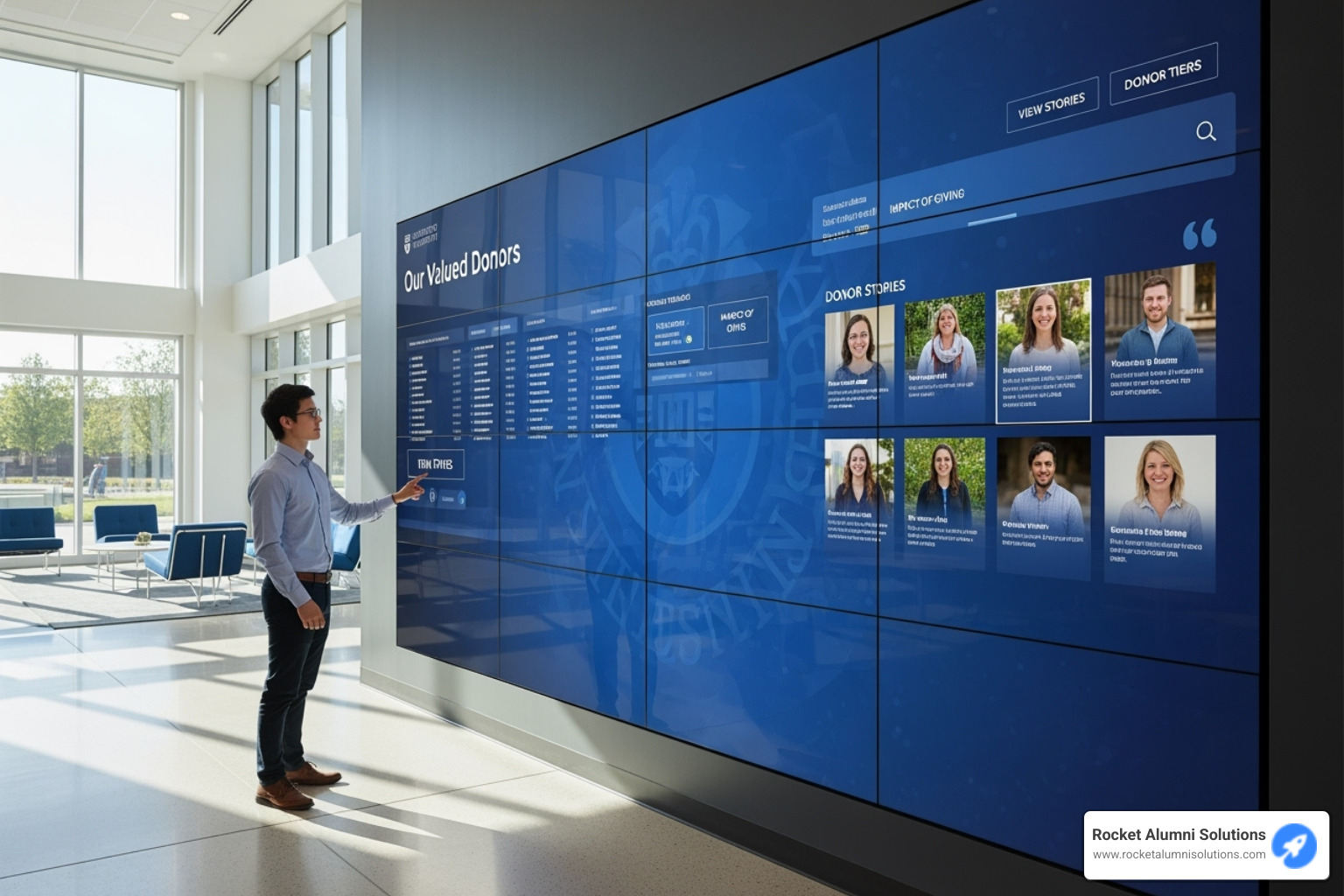
This holistic approach brings together hardware, software, compelling content, and interactive features. When these elements work in harmony, you create an experience that is far more powerful than the sum of its parts.
The Technology Backbone: Hardware and Software
Your digital donor recognition system needs a reliable technology foundation. This starts with commercial-grade screens built for continuous operation, with lifespans of 50,000 to 70,000 hours. Touchscreen capabilities transform the display from a passive monument into an engaging conversation, allowing donors to search for their names and explore impact stories.
The real magic, however, is in the software. A cloud-based Content Management System (CMS) is the brain of the operation, allowing your staff to manage content from any device without technical expertise. The most valuable feature is seamless CRM integration, which connects your recognition system to your donor database. This eliminates duplicate data entry and ensures that a donor's recognition is updated automatically and accurately.
When evaluating platforms, prioritize intuitive content management, professional templates, analytics, and robust security. To see how this comes together, check out our Design and Install Process Video.
Content is King: The Power of Storytelling and Branding
Technology alone won't inspire donors if your content falls flat. Your digital donor recognition display must be a storytelling platform that brings your mission to life. Every visual element should align with your institution's brand, building trust and reinforcing professionalism.
Your content should always connect back to your mission. Use a mix of formats to tell your story:
- Donor profiles can honor supporters by sharing their personal motivations for giving.
- Impact stories connect contributions to tangible outcomes, like a new scholarship or research breakthrough.
- Beneficiary testimonials, especially videos from students and faculty, add an authentic voice that resonates with donors.
- Video engagement combines movement, imagery, and sound to evoke emotion and communicate complex messages effectively.
Interactive Elements: From Passive Viewing to Active Engagement
Interactivity is what transforms a digital display into a memorable experience. Inviting donors to engage deepens their relationship with your institution.
Key interactive features include:
- Searchable lists that allow donors and their families to easily find their names and review their giving history.
- Detailed donor profiles that appear when a name is tapped, featuring photos, videos, and personal stories.
- Impact videos that illustrate how donations translate into real-world outcomes.
- Social media integration that allows donors to share their recognition with their networks, extending your reach.
- Gamification elements, like digital badges for giving milestones, can add a layer of fun and encourage participation.
The result is a personal connection that inspires continued support. To see these elements in action, explore our showcase of interactive digital donor displays.
A Practical Guide to Implementing Your Digital Donor Wall
Implementing a digital donor recognition wall is an exciting opportunity to transform donor connections. A successful implementation takes about six to nine months and requires careful planning, the right team, and a clear vision.

An important first step is securing buy-in from your board, senior leadership, and key donors. Their support will make the implementation process much smoother. You'll also want to establish a clear donor hierarchy that feels fair and is flexible enough to evolve with your fundraising programs.
Technical Considerations and Potential Challenges
As you plan your implementation, you'll want to address a few key technical areas:
- System integration: Your digital display must communicate smoothly with your existing donor database or CRM to eliminate manual data entry and ensure accuracy.
- Data privacy: Your system should accommodate all donor preferences, from prominent features to anonymous giving. Being transparent about how you protect donor data builds trust. A solid change management strategy for digital projects can help guide these considerations.
- Accessibility: Design your display to be accessible to everyone. This includes mounting screens at appropriate heights, providing high-contrast modes, including closed captions on videos, and ensuring intuitive navigation.
- Content development: A dynamic display requires fresh content. Plan for who will gather donor stories, create videos, and write narratives. Content templates and user-generated content can help streamline this process.
- Staff training: Comprehensive training and ongoing support are crucial to ensure your team feels comfortable and confident using the new system.
Measuring the ROI of Digital Donor Recognition
While there's an upfront cost, digital donor recognition is a strategic investment with a clear return. A typical budget includes hardware, installation, software customization, and initial content development, followed by a predictable annual software license. As a rule of thumb for capital campaigns, it's wise to budget around 8-14% of the total project cost for donor recognition.
Compare this to the unpredictable, recurring costs of traditional plaques. Digital systems convert variable expenses into manageable fixed costs. The real returns, however, appear in your fundraising metrics. Organizations report retention rate improvements of 15-25% and find that major gift cultivation cycles accelerate. Many institutions see a positive ROI within three to five years from cost savings and increased giving alone.
Leveraging Displays for Campaigns and Events
Your digital donor recognition display is an active fundraising tool. Use it to show real-time campaign progress with a fundraising thermometer, creating momentum for giving days and capital campaigns.
During special events like galas or homecoming, you can transform the display to feature sponsors or a live fundraising ticker. Naming opportunities come alive when visitors can tap a name to see videos and stories of impact. You can also integrate QR codes to create seamless giving opportunities, allowing an inspired visitor to donate directly from their phone. For more ideas, explore our digital recognition solutions.
Innovative Examples of Digital Recognition in Practice
Digital donor recognition offers limitless creative possibilities that go far beyond a scrolling list of names. The most memorable installations blend technology with creativity to create experiences that resonate with donors.
Consider these innovative approaches:
- Art-inspired installations: Transform donor names into an evolving digital art piece, perhaps inspired by your university's architecture or natural surroundings. The display becomes a living work of art that grows with your donor community.
- Interactive storytelling walls: Allow visitors to become active participants. At institutions like Children's Hospital of Philadelphia and Wilfrid Laurier University, visitors can tap a donor's name to watch a video message or browse a photo gallery showing the impact of their gift.
- Mission-focused themes: Tie your recognition directly to your purpose. A university might use a digital tree that grows with each new donor or a constellation where each star represents a supporter.
- Dynamic progress displays: For capital campaigns, use real-time thermometers with engaging animations to show progress toward a goal, creating momentum and inspiring participation.
- Augmented reality (AR): Offer futuristic experiences where a visitor can scan a QR code to see a building's construction funded by donors or watch a virtual thank-you from a scholarship recipient.
- Hybrid recognition walls: Blend tradition with innovation by surrounding a permanent architectural element, like etched glass, with dynamic digital screens that tell the ongoing story of your philanthropic community.
- Virtual donor walls: Extend recognition globally with a virtual wall on your website, allowing supporters anywhere to feel connected and share their recognition on social media.
- Athletic halls of fame: Use interactive displays to showcase athlete achievements, team histories, and the donors who made these successes possible.
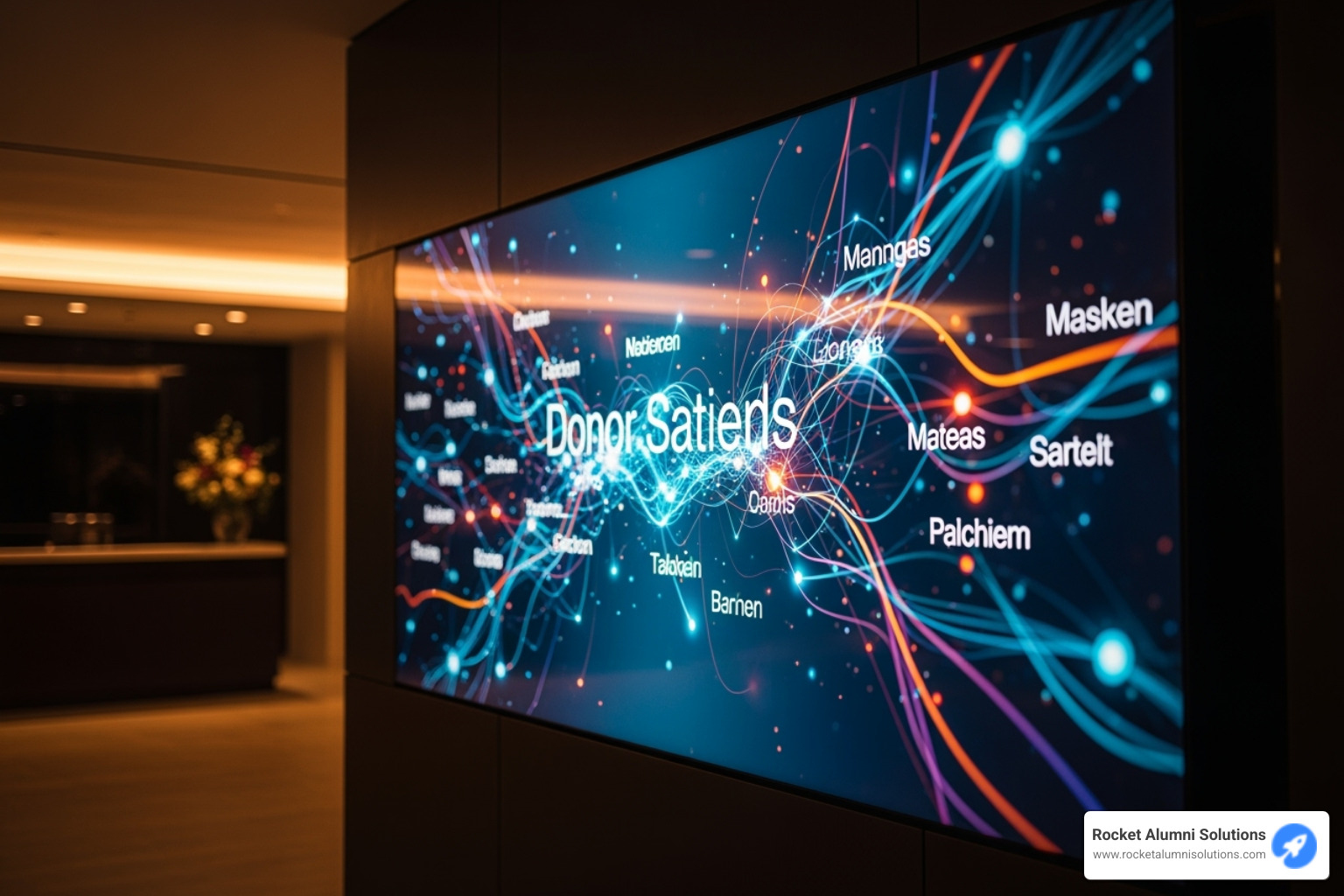
The common thread is personalization. Today's donors want to understand their impact and share their stories. Digital donor recognition makes this possible in ways traditional methods never could. To see how we've helped universities bring their visions to life, explore our case study of a university digital donor wall project.
Frequently Asked Questions about Digital Donor Recognition
As you consider this technology, you likely have questions. Having helped hundreds of institutions make this transition, I've addressed the most common concerns about digital donor recognition.
Won't digital recognition feel less permanent than a physical plaque?
This is a common concern, but digital donor recognition actually provides a more enduring form of recognition. Physical plaques can be lost or put in storage during renovations, but digital systems live in secure digital archives that persist regardless of facility changes. No donor is ever forgotten.
Furthermore, physical walls have limited space, forcing painful decisions about which names to remove. Digital displays offer unlimited capacity, ensuring every donor can be honored indefinitely. Finally, consistent visibility is key. A static plaque can become background noise, but a dynamic digital display keeps recognition fresh and engaging, giving donors a reason to return and reconnect.
How do we justify the investment to our board?
Frame digital donor recognition as strategic infrastructure for your advancement program, not a discretionary expense. Start by comparing the total cost of ownership over ten years. The unpredictable, recurring costs of traditional plaques often exceed the predictable subscription of a digital system.
The real justification comes from measurable returns. Organizations report 15-25% improvements in donor retention, and major gift cultivation cycles can accelerate by 4-6 months. Most organizations achieve a positive ROI within 3-5 years from cost savings, increased efficiency, and improved donor lifetime value. Your team will spend less time on logistics and more time building relationships.
How do we keep the content fresh and engaging over time?
Maintaining fresh content is manageable with a clear plan. Start with a content calendar to schedule rotating spotlights on different donors, departments, or projects. This ensures every donor gets a moment to shine while keeping the display dynamic.
Tie your content to campus life. Feature alumni donors during homecoming or update campaign progress during year-end giving. User-generated content, like thank-you videos from students, is a powerful and easy way to gather authentic stories. Finally, schedule quarterly content reviews to assess what's working and plan new features. You can also engage volunteers or interns to create a sustainable content pipeline. By treating your display as a living program, you ensure it remains captivating for years to come. For support, we're here to help at Rocket Alumni Solutions.
Conclusion: The Future of Philanthropic Stewardship
The shift from static plaques to digital donor recognition is about reimagining how we build lasting relationships with supporters. Philanthropy has always been about connection, and digital solutions allow us to foster that connection more personally and meaningfully than ever before. When we can instantly show a donor the student they helped or the lab their gift funded, we invite them into an ongoing story of impact.
This is what modern philanthropy looks like: dynamic, personal, and engaging for donors of every generation. Digital donor recognition creates authentic moments of connection that inspire not just one gift, but a lifetime of giving.
At Rocket Alumni Solutions, we specialize in digital recognition for universities and educational institutions. We are proud to serve hundreds of schools, including the University of Maryland, Dartmouth College, West Texas A&M University, and Emory University. Our platforms are designed to be intuitive for your team while creating memorable experiences for your donors.
The future of philanthropic stewardship is about using technology to bring us closer together and building a culture of gratitude that inspires generosity for generations to come. We'd love to show you how our solutions can transform your approach. Explore digital recognition solutions for your university and let's discuss what's possible when gratitude meets innovation.



















































































































